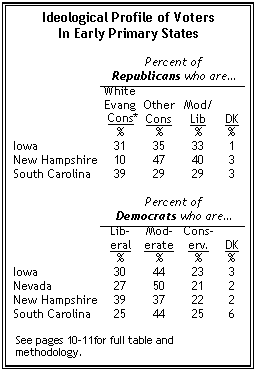Summary of Findings

Increased public support for the social safety net, signs of growing public concern about income inequality, and a diminished appetite for assertive national security policies have improved the political landscape for the Democrats as the 2008 presidential campaign gets underway.
At the same time, many of the key trends that nurtured the Republican resurgence in the mid-1990s have moderated, according to Pew’s longitudinal measures of the public’s basic political, social and economic values. The proportion of Americans who support traditional social values has edged downward since 1994, while the proportion of Americans expressing strong personal religious commitment also has declined modestly.
Even more striking than the changes in some core political and social values is the dramatic shift in party identification that has occurred during the past five years. In 2002, the country was equally divided along partisan lines: 43% identified with the Republican Party or leaned to the GOP, while an identical proportion said they were Democrats. Today, half of the public (50%) either identifies as a Democrat or says they lean to the Democratic Party, compared with 35% who align with the GOP.
Yet the Democrats’ growing advantage in party identification is tempered by the fact that the Democratic Party’s overall standing with the public is no better than it was when President Bush was first inaugurated in 2001. Instead, it is the Republican Party that has rapidly lost public support, particularly among political independents. Faced with an unpopular president who is waging an increasingly unpopular war, the proportion of Americans who hold a favorable view of the Republican Party stands at 41%, down 15 points since January 2001. But during that same period, the proportion expressing a positive view of Democrats has declined by six points, to 54%.

The study of the public’s political values and attitudes by the Pew Research Center for the People & the Press — the most recent in a series of such reports dating back to 1987 — finds a pattern of rising support since the mid-1990s for government action to help disadvantaged Americans. More Americans believe that the government has a responsibility to take care of people who cannot take care of themselves, and that it should help more needy people even if it means going deeper into debt.
These attitudes have undergone a major change since 1994, when the Republicans won control of Congress. In particular, 54% say the government should help more needy people, even if it adds to the nation’s debt, up from just 41% in 1994. All party groups are now more supportive of government aid to the poor, though Republicans remain much less supportive than Democrats or independents if it means adding to the deficit.
Despite these favorable shifts in support for more government help for the poor, 69% agree that “poor people have become too dependent on government assistance programs.” Still, the number in agreement has been declining over the past decade.

More broadly, the poll finds that money worries are rising. More than four-in-ten (44%) say they “don’t have enough money to make ends meet,” up from 35% in 2002. While a majority continues to say they are “pretty well satisfied” with their personal financial situation, that number is lower than it has been in more than a decade.
In addition, an increasing number of Americans subscribe to the sentiment “today it’s really true that the rich just get richer while the poor get poorer.” Currently, 73% concur with that sentiment, up from 65% five years ago. Growing concerns about income inequality are most apparent among affluent Americans; large percentages of lower-income people have long held this opinion.
The new survey also shows that the deep partisan fissure in values and core attitudes revealed in Pew’s previous survey in 2003 has narrowed slightly. But Republicans and Democrats remain far apart in their fundamental attitudes toward government, national security, social values, and even in evaluations of personal finances. Three-in-four (74%) Republicans with annual incomes of less than $50,000 say they are “pretty well satisfied” with their financial conditions compared with 40% of Democrats and 39% of independents with similar incomes.
Even as Americans express greater commitment to solving domestic problems, they voice more hesitancy about global engagement. They also are less disposed than five years ago to favor a strong military as the best way to ensure peace.

In 2002, less than a year after the Sept. 11 terrorist attacks, more than six-in-ten agreed with the statement, “The best way to ensure peace is through military strength.” Today, about half express similar confidence in military power.
The latest values survey, conducted Dec. 12, 2006-Jan. 9, 2007, finds a reversal of increased religiosity observed in the mid-1990s. While most Americans remain religious in both belief and practice, the percentage expressing strong religious beliefs has edged down since the 1990s. And the survey finds an increase in the relatively small percentage of the public that can be categorized as secular.
In Pew surveys since the beginning of 2006, 12% identified themselves as unaffiliated with a religious tradition. That compares with 8% in the Pew values survey in 1987. This change appears to be generational in nature, with each new generation displaying lower levels of religious commitment than the preceding one.
In addition, political differences in levels of religious commitment are larger now than in years past. Republicans are at least as religious as they were 10 or 20 years ago, based on the numbers expressing belief in God, citing prayer as important, and other measures. By contrast, Democrats express lower levels of commitment than in the late 1980s and 1990s.

At the same time, the survey records further declines in traditional social attitudes. The poll finds greater public acceptance of homosexuality and less desire for women to play traditional roles in society. Both represent a continuation of trends that have been apparent over the past 20 years, and have occurred mostly among older people. The younger generations have changed the least, as they have consistently expressed more accepting points of view over the past 20 years.
Divides on some once-contentious issues also appear to be closing. In 1995, 58% said they favored affirmative action programs designed to help blacks, women, and other minorities get better jobs. That percentage has risen steadily since, and stands at 70% in the current poll. Gains in support for affirmative action have occurred to almost the same extent among Republicans (+8), Democrats (+10), and Independents (+14).

Changes nationally in the beliefs of Americans on social, political and religious values tell a revealing but incomplete story. The proportion of voters who hold certain politically relevant core beliefs varies widely from state to state, further complicating an already complicated 2008 election campaign. For example, politically conservative, white evangelical Christians make up 10% of all Republicans and Republican leaners in New Hampshire — currently the first state to hold its presidential primaries in 2008 — but 39% of all GOP partisans in South Carolina where primary voters go to the polls several days later. On the Democratic s ide, the proportion of Democrats who say they are politically liberal ranges from 38% in California to 25% in South Carolina. (See pages 10-11 for a fuller ideological profiling of key primary states)
Among other key findings from the wide-ranging survey:
- The public expresses highly favorable views of many leading corporations. Johnson & Johnson and Google have the most positive images of 23 corporations tested. At the bottom of the list: Halliburton, which is viewed favorably by fewer than half of those familiar enough with the company to give it a rating.
- Views of many corporations vary significantly among Democrats along class lines. Two-thirds of working-class Democrats have a favorable view of Wal-Mart compared with 45% of professional-class Democrats.
- Americans are worried more that businesses rather than government are snooping into their lives. About three-in-four (74%) say they are concerned that business corporations are collecting too much personal information while 58% express the same concern about the government.
- The public is losing confidence in itself. A dwindling majority (57%) say they have a good deal of confidence in the wisdom of the American people when it comes to making political decisions. Similarly, the proportion who agrees that Americans “can always find a way to solve our problems” has dropped 16 points in the past five years.
- Americans feel increasingly estranged from their government. Barely a third (34%) agree with the statement, “most elected officials care what people like me think,” nearly matching the 20-year low of 33% recorded in 1994 and a 10-point drop since 2002.
- Young people continue to hold a more favorable view of government than do other Americans. At the same time, young adults express the least interest in voting and other forms of political participation.
- Interpersonal racial attitudes continue to moderate. More than eight-in-ten (83%) agree that “it’s all right for blacks and whites to date,” up six percentage points since 2003 and 13 points from a Pew survey conducted 10 years ago.
- Republicans are increasingly divided over the cultural impact of immigrants. Nearly seven-in-ten (68%) conservative Republicans say immigrants threaten American customs, compared with 43% of GOP moderates and liberals. Democrats have long been divided along ideological lines, but the GOP previously had not been.
Roadmap to the Report
Section 1, which begins on p. 7, describes the striking shift in party identification over the past five years, the public’s views of both parties, and the ideological profile of the early presidential primary states. Section 2, which details the public’s views of the government safety net, success and empowerment, and personal finances, begins on p. 12. Section 3 (p. 19) covers public attitudes toward foreign policy and national security. Section 4 (p. 30) covers opinions about religion and social issues. Section 5 (p. 39) describes changing attitudes toward race and race relations. Section 6 (p. 45) discusses the public’s complex views about government and political participation. Opinions about business, and ratings for individual corporations, are covered in Section 7, which begins on p. 52. Section 8 covers public views about civil liberties, the environment, and science.